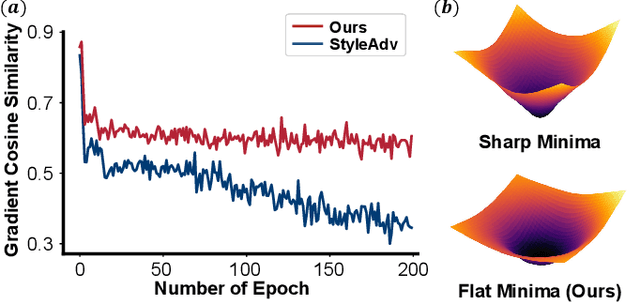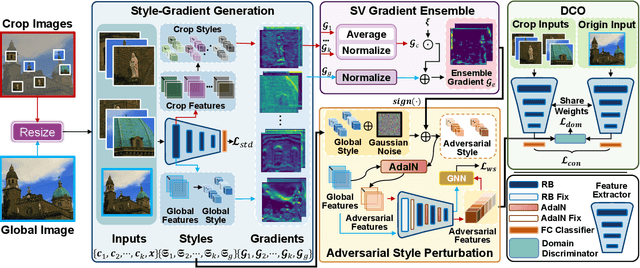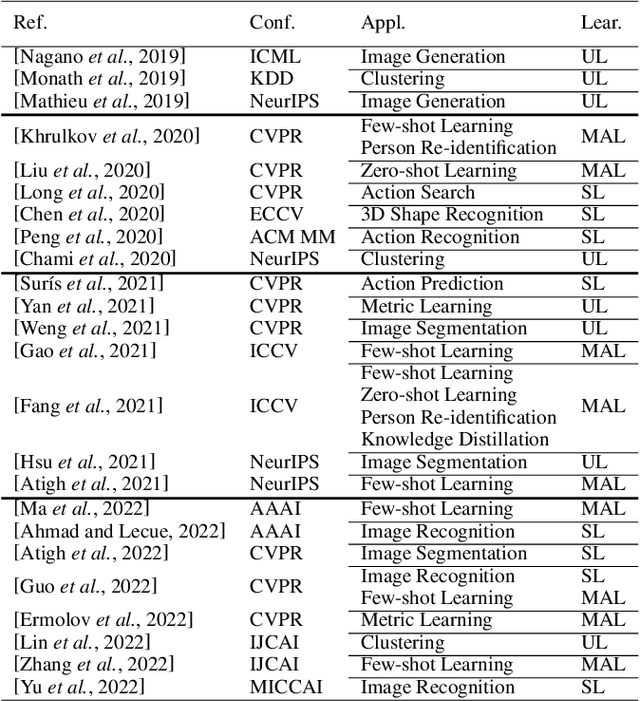Pengfei Fang
On Distilling the Displacement Knowledge for Few-Shot Class-Incremental Learning
Dec 17, 2024Abstract:Few-shot Class-Incremental Learning (FSCIL) addresses the challenges of evolving data distributions and the difficulty of data acquisition in real-world scenarios. To counteract the catastrophic forgetting typically encountered in FSCIL, knowledge distillation is employed as a way to maintain the knowledge from learned data distribution. Recognizing the limitations of generating discriminative feature representations in a few-shot context, our approach incorporates structural information between samples into knowledge distillation. This structural information serves as a remedy for the low quality of features. Diverging from traditional structured distillation methods that compute sample similarity, we introduce the Displacement Knowledge Distillation (DKD) method. DKD utilizes displacement rather than similarity between samples, incorporating both distance and angular information to significantly enhance the information density retained through knowledge distillation. Observing performance disparities in feature distribution between base and novel classes, we propose the Dual Distillation Network (DDNet). This network applies traditional knowledge distillation to base classes and DKD to novel classes, challenging the conventional integration of novel classes with base classes. Additionally, we implement an instance-aware sample selector during inference to dynamically adjust dual branch weights, thereby leveraging the complementary strengths of each approach. Extensive testing on three benchmarks demonstrates that DDNet achieves state-of-the-art results. Moreover, through rigorous experimentation and comparison, we establish the robustness and general applicability of our proposed DKD method.
PEARL: Input-Agnostic Prompt Enhancement with Negative Feedback Regulation for Class-Incremental Learning
Dec 14, 2024Abstract:Class-incremental learning (CIL) aims to continuously introduce novel categories into a classification system without forgetting previously learned ones, thus adapting to evolving data distributions. Researchers are currently focusing on leveraging the rich semantic information of pre-trained models (PTMs) in CIL tasks. Prompt learning has been adopted in CIL for its ability to adjust data distribution to better align with pre-trained knowledge. This paper critically examines the limitations of existing methods from the perspective of prompt learning, which heavily rely on input information. To address this issue, we propose a novel PTM-based CIL method called Input-Agnostic Prompt Enhancement with Negative Feedback Regulation (PEARL). In PEARL, we implement an input-agnostic global prompt coupled with an adaptive momentum update strategy to reduce the model's dependency on data distribution, thereby effectively mitigating catastrophic forgetting. Guided by negative feedback regulation, this adaptive momentum update addresses the parameter sensitivity inherent in fixed-weight momentum updates. Furthermore, it fosters the continuous enhancement of the prompt for new tasks by harnessing correlations between different tasks in CIL. Experiments on six benchmarks demonstrate that our method achieves state-of-the-art performance. The code is available at: https://github.com/qinyongchun/PEARL.
SVasP: Self-Versatility Adversarial Style Perturbation for Cross-Domain Few-Shot Learning
Dec 12, 2024



Abstract:Cross-Domain Few-Shot Learning (CD-FSL) aims to transfer knowledge from seen source domains to unseen target domains, which is crucial for evaluating the generalization and robustness of models. Recent studies focus on utilizing visual styles to bridge the domain gap between different domains. However, the serious dilemma of gradient instability and local optimization problem occurs in those style-based CD-FSL methods. This paper addresses these issues and proposes a novel crop-global style perturbation method, called \underline{\textbf{S}}elf-\underline{\textbf{V}}ersatility \underline{\textbf{A}}dversarial \underline{\textbf{S}}tyle \underline{\textbf{P}}erturbation (\textbf{SVasP}), which enhances the gradient stability and escapes from poor sharp minima jointly. Specifically, SVasP simulates more diverse potential target domain adversarial styles via diversifying input patterns and aggregating localized crop style gradients, to serve as global style perturbation stabilizers within one image, a concept we refer to as self-versatility. Then a novel objective function is proposed to maximize visual discrepancy while maintaining semantic consistency between global, crop, and adversarial features. Having the stabilized global style perturbation in the training phase, one can obtain a flattened minima in the loss landscape, boosting the transferability of the model to the target domains. Extensive experiments on multiple benchmark datasets demonstrate that our method significantly outperforms existing state-of-the-art methods. Our codes are available at https://github.com/liwenqianSEU/SVasP.
Towards Few-Shot Learning in the Open World: A Review and Beyond
Aug 19, 2024



Abstract:Human intelligence is characterized by our ability to absorb and apply knowledge from the world around us, especially in rapidly acquiring new concepts from minimal examples, underpinned by prior knowledge. Few-shot learning (FSL) aims to mimic this capacity by enabling significant generalizations and transferability. However, traditional FSL frameworks often rely on assumptions of clean, complete, and static data, conditions that are seldom met in real-world environments. Such assumptions falter in the inherently uncertain, incomplete, and dynamic contexts of the open world. This paper presents a comprehensive review of recent advancements designed to adapt FSL for use in open-world settings. We categorize existing methods into three distinct types of open-world few-shot learning: those involving varying instances, varying classes, and varying distributions. Each category is discussed in terms of its specific challenges and methods, as well as its strengths and weaknesses. We standardize experimental settings and metric benchmarks across scenarios, and provide a comparative analysis of the performance of various methods. In conclusion, we outline potential future research directions for this evolving field. It is our hope that this review will catalyze further development of effective solutions to these complex challenges, thereby advancing the field of artificial intelligence.
Text Image Inpainting via Global Structure-Guided Diffusion Models
Feb 02, 2024



Abstract:Real-world text can be damaged by corrosion issues caused by environmental or human factors, which hinder the preservation of the complete styles of texts, e.g., texture and structure. These corrosion issues, such as graffiti signs and incomplete signatures, bring difficulties in understanding the texts, thereby posing significant challenges to downstream applications, e.g., scene text recognition and signature identification. Notably, current inpainting techniques often fail to adequately address this problem and have difficulties restoring accurate text images along with reasonable and consistent styles. Formulating this as an open problem of text image inpainting, this paper aims to build a benchmark to facilitate its study. In doing so, we establish two specific text inpainting datasets which contain scene text images and handwritten text images, respectively. Each of them includes images revamped by real-life and synthetic datasets, featuring pairs of original images, corrupted images, and other assistant information. On top of the datasets, we further develop a novel neural framework, Global Structure-guided Diffusion Model (GSDM), as a potential solution. Leveraging the global structure of the text as a prior, the proposed GSDM develops an efficient diffusion model to recover clean texts. The efficacy of our approach is demonstrated by thorough empirical study, including a substantial boost in both recognition accuracy and image quality. These findings not only highlight the effectiveness of our method but also underscore its potential to enhance the broader field of text image understanding and processing. Code and datasets are available at: https://github.com/blackprotoss/GSDM.
Brain-Conditional Multimodal Synthesis: A Survey and Taxonomy
Jan 03, 2024Abstract:In the era of Artificial Intelligence Generated Content (AIGC), conditional multimodal synthesis technologies (e.g., text-to-image, text-to-video, text-to-audio, etc) are gradually reshaping the natural content in the real world. The key to multimodal synthesis technology is to establish the mapping relationship between different modalities. Brain signals, serving as potential reflections of how the brain interprets external information, exhibit a distinctive One-to-Many correspondence with various external modalities. This correspondence makes brain signals emerge as a promising guiding condition for multimodal content synthesis. Brian-conditional multimodal synthesis refers to decoding brain signals back to perceptual experience, which is crucial for developing practical brain-computer interface systems and unraveling complex mechanisms underlying how the brain perceives and comprehends external stimuli. This survey comprehensively examines the emerging field of AIGC-based Brain-conditional Multimodal Synthesis, termed AIGC-Brain, to delineate the current landscape and future directions. To begin, related brain neuroimaging datasets, functional brain regions, and mainstream generative models are introduced as the foundation of AIGC-Brain decoding and analysis. Next, we provide a comprehensive taxonomy for AIGC-Brain decoding models and present task-specific representative work and detailed implementation strategies to facilitate comparison and in-depth analysis. Quality assessments are then introduced for both qualitative and quantitative evaluation. Finally, this survey explores insights gained, providing current challenges and outlining prospects of AIGC-Brain. Being the inaugural survey in this domain, this paper paves the way for the progress of AIGC-Brain research, offering a foundational overview to guide future work.
PEAN: A Diffusion-based Prior-Enhanced Attention Network for Scene Text Image Super-Resolution
Nov 29, 2023



Abstract:Scene text image super-resolution (STISR) aims at simultaneously increasing the resolution and readability of low-resolution scene text images, thus boosting the performance of the downstream recognition task. Two factors in scene text images, semantic information and visual structure, affect the recognition performance significantly. To mitigate the effects from these factors, this paper proposes a Prior-Enhanced Attention Network (PEAN). Specifically, a diffusion-based module is developed to enhance the text prior, hence offering better guidance for the SR network to generate SR images with higher semantic accuracy. Meanwhile, the proposed PEAN leverages an attention-based modulation module to understand scene text images by neatly perceiving the local and global dependence of images, despite the shape of the text. A multi-task learning paradigm is employed to optimize the network, enabling the model to generate legible SR images. As a result, PEAN establishes new SOTA results on the TextZoom benchmark. Experiments are also conducted to analyze the importance of the enhanced text prior as a means of improving the performance of the SR network. Code will be made available at https://github.com/jdfxzzy/PEAN.
Hyperbolic Audio-visual Zero-shot Learning
Aug 24, 2023



Abstract:Audio-visual zero-shot learning aims to classify samples consisting of a pair of corresponding audio and video sequences from classes that are not present during training. An analysis of the audio-visual data reveals a large degree of hyperbolicity, indicating the potential benefit of using a hyperbolic transformation to achieve curvature-aware geometric learning, with the aim of exploring more complex hierarchical data structures for this task. The proposed approach employs a novel loss function that incorporates cross-modality alignment between video and audio features in the hyperbolic space. Additionally, we explore the use of multiple adaptive curvatures for hyperbolic projections. The experimental results on this very challenging task demonstrate that our proposed hyperbolic approach for zero-shot learning outperforms the SOTA method on three datasets: VGGSound-GZSL, UCF-GZSL, and ActivityNet-GZSL achieving a harmonic mean (HM) improvement of around 3.0%, 7.0%, and 5.3%, respectively.
Hyperbolic Geometry in Computer Vision: A Survey
Apr 21, 2023



Abstract:Hyperbolic geometry, a Riemannian manifold endowed with constant sectional negative curvature, has been considered an alternative embedding space in many learning scenarios, \eg, natural language processing, graph learning, \etc, as a result of its intriguing property of encoding the data's hierarchical structure (like irregular graph or tree-likeness data). Recent studies prove that such data hierarchy also exists in the visual dataset, and investigate the successful practice of hyperbolic geometry in the computer vision (CV) regime, ranging from the classical image classification to advanced model adaptation learning. This paper presents the first and most up-to-date literature review of hyperbolic spaces for CV applications. To this end, we first introduce the background of hyperbolic geometry, followed by a comprehensive investigation of algorithms, with geometric prior of hyperbolic space, in the context of visual applications. We also conclude this manuscript and identify possible future directions.
Improving Scene Text Image Super-Resolution via Dual Prior Modulation Network
Feb 21, 2023



Abstract:Scene text image super-resolution (STISR) aims to simultaneously increase the resolution and legibility of the text images, and the resulting images will significantly affect the performance of downstream tasks. Although numerous progress has been made, existing approaches raise two crucial issues: (1) They neglect the global structure of the text, which bounds the semantic determinism of the scene text. (2) The priors, e.g., text prior or stroke prior, employed in existing works, are extracted from pre-trained text recognizers. That said, such priors suffer from the domain gap including low resolution and blurriness caused by poor imaging conditions, leading to incorrect guidance. Our work addresses these gaps and proposes a plug-and-play module dubbed Dual Prior Modulation Network (DPMN), which leverages dual image-level priors to bring performance gain over existing approaches. Specifically, two types of prior-guided refinement modules, each using the text mask or graphic recognition result of the low-quality SR image from the preceding layer, are designed to improve the structural clarity and semantic accuracy of the text, respectively. The following attention mechanism hence modulates two quality-enhanced images to attain a superior SR result. Extensive experiments validate that our method improves the image quality and boosts the performance of downstream tasks over five typical approaches on the benchmark. Substantial visualizations and ablation studies demonstrate the advantages of the proposed DPMN. Code is available at: https://github.com/jdfxzzy/DPMN.
 Add to Chrome
Add to Chrome Add to Firefox
Add to Firefox Add to Edge
Add to Edge